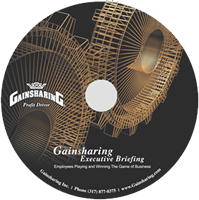One of my Gainsharing clients made a casual comment to me recently that they were in a “Cost containment mode”. There must be thousands of management people thinking that same thought these days!
As Mark Twain said, “None of us are smart enough to remember all we know.”
With that in mind, a quick review of some basic/familiar cost containment ideas may be worthwhile.
(1) LABOR COSTS
Labor costs are almost always a focus in productivity improvement efforts for two reasons. First, labor is often a significant expense. And second, the people spend the money in many of the other cost categories. A focus on reducing labor costs typically drives savings in many areas.
– You Can’t Hit a Target You Can’t See
To control/reduce labor costs you need to have labor cost targets. You need to break the productivity goals down so your employees have an answer to,
“What do I need to do today, on my shift, to be doing my part to hit our goal
that will lead to the bonus we are shooting for?”
I have a challenge for you.
If we went into your operations today, would we find that your people have an answer to that question?
If not, it’s our (management’s) fault! Because if we were telling them that information, they would know, and this would certainly influence their performance.
Your labor cost control efforts are going to miss the mark if they are not broken down to this level and visible to everyone involved.
– “Labor Costs” Include Everyone On the Payroll
Although most people think of the production people when we think of labor cost reduction, these principles apply to those who are “not touching the product” also.
The specifics are a bit different, but the principles are the same. Often the “support people” (maintenance, scheduling, customer service) can have even greater leverage on improving overall productivity than the “production people” since solving/avoiding problems involves these support areas.
(2) MATERIAL
Material cost savings opportunities can be HUGE. But most companies are not doing a particularly good job of harvesting the savings available here.
The problem is, for most workers, material is like “sand on the beach”. There’s always more. They try to avoid scrap and excess material usage, but if there’s a problem, they just get more material. There’s lots of it!
People are generally more “attentive” when problems will hit them in their pocketbook. They need a personal connection to making the savings happen. They need “skin in the game.”
– What’s the Plan?
Next, we need to detail what the action plan is to save material costs and a heightened awareness of the money involved in potential savings. Where are the biggest opportunities? What is the plan to attack them? If our approach is too general, we get a diffusion of efforts, with employees going in different directions, leading to disappointing results.
Do your employees know where the biggest material cost savings opportunities are? Is there an agreed upon action plan to drive the savings? Do they know what it is?
(3) MOTIVATION
As a business owner once asked me, “How do I get that extra bit of effort from my people?
When we quote a job, we assume that extra edge of motivation. How do we get that from our people on a regular basis?”
That’s the question isn’t it? How do we get our people to be enthusiastic about getting to that higher level of performance and keep them there?
– Connection
This is both giving them “skin in the game” and setting up both expectations and feedback so there is a personal connection to what happens.
If I think my performance is going to be blended into a large group, I may not worry about it much. But if I think that my performance will be visible and traceable back to me, I’m much more likely to make sure I hit my numbers.
They can’t hide in the group. People are going to see that they’re not pulling their weight!
– How Are We Doing On Our Numbers Today?
Frequent feedback is a “must” to get the connection that we’re looking for. That means weekly, daily, or maybe best of all, hourly. When people have a personal connection to the information, they’ll want to know where they stand. This is a “must” to make their work more like a game.
The information fosters the connection. The connection drives the involvement, concern, accountability, and performance. Once they get hooked on getting the information, it’s powerful! Again, if they don’t know, it’s our fault.
(4) In Conclusion
What cost containment efforts can you add to what you’re already doing? Do you have the focused efforts, personal connection to results, visibility, and communication that you really need?
It’s not how much you make. It’s how much you keep!


